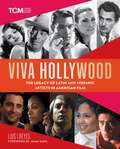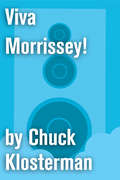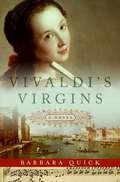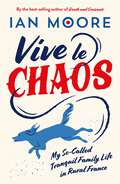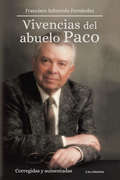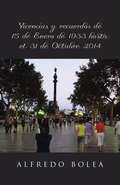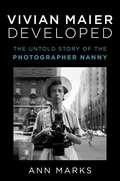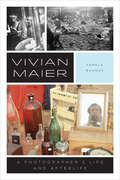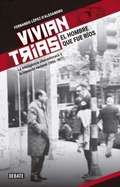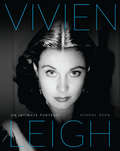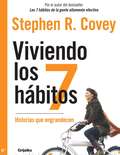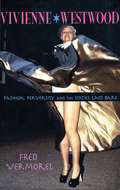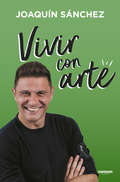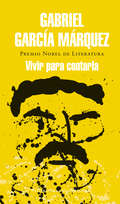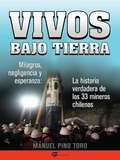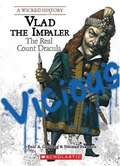- Table View
- List View
Viva Hollywood: The Legacy of Latin and Hispanic Artists in American Film (Turner Classic Movies)
by Luis I. ReyesThrough an authoritative narrative and lavish photography, this is an in-depth history of the stars, films, achievements, and influence of the Hispanic and Latino community in Hollywood history from the silent era to the present day.Overcoming obstacles of prejudice, ignorance, and stereotyping, this group has given the world some of its most beloved stars and told some of its most indelible stories. Viva Hollywood examines the stars in front of the screen as well as the people behind-the-scenes who have created a rich legacy across more than 100 years.The role of Latin women on screen is explored through the professional lives of Dolores Del Rio, Rita Hayworth, Raquel Welch, Salma Hayek, Penélope Cruz, and many more. The book covers the films and careers of actors ranging from silent screen idol Antonio Moreno, to international Oscar-winning star Anthony Quinn, to Andy Garcia and Antonio Banderas. A spotlight is also given to craftspeople who elevated the medium with their artistry—visionaries like cinematographer John Alonzo, Citizen Kane scenic artist Mario Larrinaga, and Oscar-winning makeup artist Beatrice de Alba.The stories of these and many others begins through a lens of stereotyped on-screen personas of Latin Lovers, sexy spitfires, banditos, and gangsters. World War II saw an embrace of Latin culture as the &“Good Neighbor Policy&” made it both fashionable and patriotic to feature stories set south of the border. Social problem films of the 1950s and '60s brought fresh looks at the community, with performances like Katy Jurado in High Noon, the cast of West Side Story, and racial inequality depicted in George Stevens's Giant. Civil Rights, the Chicano Movement, and the work of activist actors such as Ricardo Montalban and Edward James Olmos influenced further change in Hollywood in subsequent decades and paved the way for modern times and stars the likes of Jennifer Lopez and Lin-Manuel Miranda.Illustrated by more than 200 full-color and black-and-white images, Viva Hollywood is both a sweeping history and a celebration of the legacy of some of the greatest art and artists ever captured on screen.
Viva Mexico! A Traveller's Account of Life in Mexico
by Charles Macomb FlandreauFirst published in 1908, this is a classic memoir about life in Mexico (from the point of a wealthy foreigner) in the years before the Revolution of 1910. Flandreau describes life on a coffee plantation, and attempts to explain Mexican character and folkways. Although much in this book is overtly racist by today's standards, Flandreau's observations are vivid and his storytelling is often compelling.
Viva Morrissey!
by Chuck KlostermanOriginally collected in Chuck Klosterman IV and now available both as a stand-alone essay and in the ebook collection Chuck Klosterman on Pop, this essay is about Morrissey fans.
Vivaldi's Virgins: A Novel
by Barbara QuickIn this enthralling new novel, Barbara Quick re-creates eighteenth-century Venice at the height of its splendor and decadence. A story of longing and intrigue, half-told truths and toxic lies, Vivaldi's Virgins unfolds through the eyes of Anna Maria dal Violin, one of the elite musicians cloistered in the foundling home where Antonio Vivaldi—known as the Red Priest of Venice—is maestro and composer. Fourteen-year-old Anna Maria, abandoned at the Ospedale della Pietà as an infant, is determined to find out who she is and where she came from. Her quest takes her beyond the cloister walls into the complex tapestry of Venetian society; from the impoverished alleyways of the Jewish Ghetto to a masked ball in the company of a king; from the passionate communal life of adolescent girls competing for their maestro's favor to the larger-than-life world of music and spectacle that kept the citizens of a dying republic in thrall. In this world, where for fully half the year the entire city is masked and cloaked in the anonymity of Carnival, nothing is as it appears to be. A virtuoso performance in the tradition of Girl with a Pearl Earring, Vivaldi's Virgins is a fascinating glimpse inside the source of Vivaldi's musical legacy, interwoven with the gripping story of a remarkable young woman's coming-of-age in a deliciously evocative time and place.
Vive le Chaos: My So-Called Tranquil Family Life in Rural France
by Ian MooreFollow the hilarious misadventures of Ian Moore and his family as their search for serenity in rural France leads them on a journey of chaos, commotion and comedy. But despite the ups and downs, the Moore family persevere in true Brit style to create a unique, colourful and ultimately rewarding life in their new home - à la campagne!
Vivekananda
by Romain Rolland S. H Vatsyayam Raghuvir SahayRomain Rolland was strongly influenced by the Vedanta philosophy of India, primarily through the works of Swami Vivekananda. He gives a brief sketch of the lives of Ramkrishna and Vivekananda and introduces the vedanta philosophy to the readers. Readers also know the life and journeys of Swami Vivekananda.
Vivekanandar
by R. MuthukumarThis book is a biography of Narendran who later became a Hindu Saint and Philosopher in India to be well known as Swami Vivekananda after his close association as disciple of Swami Ramakrishna Paramahamsa, a great Hindu Saint and Philosopher. The book gives a brief account of his role as a preacher of Hindu Religion particularly his religious tour to U.S. and his famous speech at Chicago and his founding the Ramakrishna Math to propagate his Guru’s preaching and unite the Hindus.
Vivencias del abuelo Paco: Corregidas y aumentadas
by Francisco Sabucedo FernándezEl libro de mi vida: 98 años de vivencias. A los 85 años -nunca es tarde si hay empeño- me puse a practicar con un viejo ordenador que se retiraba del servicio. Confieso que estuve a punto de mandar todo al infierno pensando en cómo me privaba de las ocupaciones que tenía en mi despacho. Pero continué,con el único propósito de que los tres jóvenes ejecutivos de la empresa tuvieran el coraje de seguirme los pasos y comenzasen a utilizar la informática. Dio resultado. Inicié este trabajo -que actualizo hoy, a mis 98 años- como un duro deporte y gracias a la insistencia de mi nieta Sonia, al entusiasmo de su madre por conocer nuestra biografía y a la paciencia que ha tenido mi esposa por las horas que le resté para dedicarme a escribir, con el nuevo y firme propósito de realizar este libro sobre mis propias vivencias para dedicárselo a todos los míos. ¿Les servirá de algo?
Vivencias y recuerdos de 15 de Enero de 1933 hasta el 31 de Octubre 2014
by Alfredo BoleaDe todo en la vida «Evidentemente este libro no trata de toda mi vida, puesto que al haber nacido en 1933, es mucho más larga; tanto a nivel profesional como personal; además de haber criado a cinco hijos. <P><P>De todos modos puedo extenderme en un segundo libro; y espero pueda escribirlo en un futuro próximo. Teniendo ganas de poder contar anécdotas de mi vida profesional y personal que seguro llevarán comentarios de muchas personas; los cuales probablemente serán de asombro y reconocimiento. Mi vida ha sido sencilla pero con muchas vivencias de todo tipo.»
Vivian Maier Developed: The Untold Story of the Photographer Nanny
by Ann MarksThe definitive biography that unlocks the remarkable story of Vivian Maier, the nanny who lived secretly as a world-class photographer, featuring nearly 400 of her images, many never seen before, placed for the first time in the context of her life.Vivian Maier, the photographer nanny whose work was famously discovered in a Chicago storage locker, captured the imagination of the world with her masterful images and mysterious life. Before posthumously skyrocketing to global fame, she had so deeply buried her past that even the families she lived with knew little about her. No one could relay where she was born or raised, if she had parents or siblings, if she enjoyed personal relationships, why she took photographs and why she didn&’t share them with others. Now, in this definitive biography, Ann Marks uses her complete access to Vivian&’s personal records and archive of 140,000 photographs to reveal the full story of her extraordinary life. Based on meticulous investigative research, Vivian Maier Developed reveals the story of a woman who fled from a family with a hidden history of illegitimacy, bigamy, parental rejection, substance abuse, violence, and mental illness to live life on her own terms. Left with a limited ability to disclose feelings and form relationships, she expressed herself through photography, creating a secret portfolio of pictures teeming with emotion, authenticity, and humanity. With limitless resilience she knocked down every obstacle in her way, determined to improve her lot in life and that of others by tirelessly advocating for the rights of workers, women, African Americans, and Native Americans. No one knew that behind the detached veneer was a profoundly intelligent, empathetic, and inspired woman—a woman so creatively gifted that her body of work would become one of the greatest photographic discoveries of the century.
Vivian Maier: A Photographer's Life and Afterlife
by Pamela Bannos“Look[s] past the mystique of the ‘eccentric nanny with a camera’ to tell the true Maier story . . . [An] extraordinary work.” —Library JournalWho was Vivian Maier? Many know her as the reclusive Chicago nanny who wandered the city for decades, constantly snapping photographs, which were unseen until they were discovered in a seemingly abandoned storage locker. They revealed her to be an inadvertent master of twentieth-century American street photography. Not long after, the news broke that Maier had recently died and had no surviving relatives. Soon the whole world knew about her preternatural work, shooting her to stardom almost overnight.But as Pamela Bannos reveals in this meticulous biography, this story of the nanny savant has blinded us to Maier’s true achievements, as well as her intentions. Most important, Bannos argues, Maier was not a nanny who moonlighted as a photographer; she was a photographer who supported herself as a nanny. In Vivian Maier: A Photographer’s Life and Afterlife, Bannos contrasts Maier’s life with the mythology that strangers—mostly the men who’ve profited from her work—have created around her absence. She shows that Maier was extremely conscientious about how her work was developed, printed, and cropped, even though she also made a clear choice never to display it. She places Maier’s fierce passion for privacy alongside the recent spread of her work around the world, and explains Maier’s careful adjustments of photographic technique, while explaining how the photographs have been misconstrued or misidentified. Bannos also uncovers new information about Maier’s immediate family, including her difficult brother, Karl—relatives once thought not to exist. This authoritative biography shows that the real story of Vivian Maier, a true visionary artist, is even more compelling than the myth.“An excellent book that reads like a mystery novel . . . Wonderful and engrossing.” —Elizabeth Currid-Halkett, author of Starstruck: The Business of Celebrity“It’s a portrait as direct as any of Maier’s, and what a distinct pleasure it is to meet her gaze again.” —The New York Times“This book is by far the finest yet published on the artist. I believe it will become a classic in the field.” —Art in America
Vivian Trías. El hombre que fue Ríos: La inteligencia checoslovaca y la izquierda nacional (1956-1977)
by Fernando López D'AlesandroCon una prosa ágil y de lectura atrapante, pero que no renuncia a la profundidad conceptual, este libro se constituye como necesario y revelador. Un documento de lectura imprescindible para comprender los distintos estadios en la evolución de la política uruguaya en general y de la izquierda en particular, y que se configura como una herramienta de análisis para pensar el futuro. En 2017 se hicieron públicos documentos que probaban que Vivian Trías, referente histórico del Partido Socialista uruguayo, había actuado como espía de los servicios de inteligencia checoslovacos durante trece años. Este descubrimiento generó una enorme ola expansiva al interior de las fuerzas de izquierda, y planteó la necesidad de una revisión de los hechos, que deberán ser reinterpretados y contextualizados a la luz de estas evidencias. Este libro parte desde los orígenes mismos del cisma del Partido Socialista en 1921, en aquella época liderado por Emilio Frugoni, para trazar el derrotero de la izquierda uruguaya, sus vaivenes en torno a la socialdemocracia, el marxismo y la "tercera posición", y el advenimiento de nuevos horizontes ante la llegada al liderazgo de Vivian Trías y su propuesta de "la rebelión de las orillas". Un liderazgo que generó contenidos y postulados que se resignifican a la luz de los documentos de reciente aparición. El Prof. Fernando López D'Alesandro tuvo acceso privilegiado a los archivos y testimonios que desataron la polémica, y los analiza con lucidez y rigor. Con una prosa ágil y de lectura atrapante, pero que no renuncia a la profundidad conceptual, este libro se constituye como necesario y revelador. Un documento de lectura imprescindible para comprender los distintos estadios en la evolución de la política uruguaya en general y de la izquierda en particular, y que se configura como una herramienta de análisis para pensar el futuro.
Vivien Leigh: A Biography
by Anne EdwardsThis is the story of the actress who became a Hollywood legend by winning the coveted role of Scarlett O’Hara in Gone with the Wind, and whose circle included both theatrical and political celebrities, from Winston Churchill to Noel Coward, John Gielgud, and Marlon Brando. But behind the dazzling exterior lay the sinister shadow of another Vivien Leigh—a shadow which pursued her throughout her aristocratic upbringing, her frustrating first marriage, her tempestuous romance with Laurence Olivier, and her meteoric rise to stardom.
Vivien Leigh: An Intimate Portrait
by Kendra BeanIn-depth research and new interviews are paired with rare and never-before-published photographs by LeighOCOs ?officialOCO photographer Angus McBean. "
Viviendo
by Adamari Lopez"Antes de recibir mi diagnóstico, andaba por la vida sin propósito, sin una razón de ser. Lo que me ha tocado vivir me hacía falta, necesitaba vivirlo. Tenía que pasar por esas experiencias dolorosas para poder ser la mujer que soy hoy día, una versión mejorada de mí misma. ” Adamari López, la actriz reconocida internacionalmente, lo tenía todo -una familia querida, un novio perfecto y un papel protagónico en una telenovela exitosa en México- cuando dos palabras le alteraron la vida para siempre: tienes cáncer. De pronto, en solo unos pocos meses, el mundo tal qual lo conocía se le derrumbó y toda su vida dio un vuelco súbito. En Viviendo, la normalmente privada López revela los triunfos y tormentos de su vida, compartiendo anécdotas de su niñez y su familia, mientras describe su camino por el cáncer de seno; la repentina enfermedad de su madre; su casamiento, uno de los días más felices de su vida; y luego lo que ella considera ser el golpe más duro de todos: el final de su matrimonio. Sin embargo, a través de todo, su fortaleza y su fe no se apagaron, y su espíritu amoroso y positivo, junto con su eterna sonrisa, la ayudaron a descubrir un nuevo y gratificante comienzo en el amor y en su vida. .
Viviendo los 7 hábitos: Historias que engrandecen
by Stephen R. CoveyGrandes historias de superación compiladas por el autor del best-seller Los 7 hábitos de la gente altamente efectiva. Desde su aparición en 1990, Los 7 hábitos de la gente altamente efectiva se convirtió en un rotundo éxito mundial y ha influido de manera positiva en la vida privada y profesional de más de 20 millones de lectores, en más de 30 idiomas. El libro que ahora publicamos es una motivadora colección de experiencias de la vida real de quienes han adoptado el sistema de Covey y han logrado sus metas gracias a su entereza y valor. Ellos nos comparten, con sus palabras, cómo los 7 hábitos los fortalecieron e inspiraron para sortear obstáculos tan graves como las crisis laborales y familiares. Los conmovedores y esperanzadores ejemplos de Viviendo los 7 hábitos son analizados por el doctor Covey para explicar el funcionamiento de su sistema y ayudar al lector a reconocer en sí mismo la libertad, su potencial y sus cualidades. Asimismo, expone posibles escenarios que deben enfrentar y controlar las personas altamente efectivas. "Ya sea que haya leído Los 7 hábitos de la gente altamente efectiva o no, las historias de este libro cambiarán su vida." Larry King "Este libro lo volverá a la vida y le ayudará a poner en práctica algunas delas lecciones más importantes del ser humano. Sin duda, ésta es otra obra maestra de Covey." Richard Carlson, autor de No te ahogues en un vaso de agua.
Vivienne Westwood: Fashion, Perversity, and the Sixties Laid Bare
by Fred VermorelVivienne Westwood was the Queen of Punk Rock and her fashions have scandalized and fascinated the world since the Sixties. Parading models bare-breasted down the catwalks of Paris, posing pantiless outside Buckingham Palace - she has an insatiable appetite for anarchic outrageousness. She has never lost her power to shock, and her continued innovations make her one of the most talked-about fashion designers in the world." "Vivienne Westwood describes for the first time in detail Westwood's childhood and early years; it also exposes the inside story of her stormy and bizarre relationship with musician and fashionista Malcolm McLaren. Fred Vermorel looks at the origins of Westwood's witty and erotic sensibility, placing it in the context of the Sixties, and throwing light on the dynamics of punk and on Westwood's later ability to tap into the inner logic of fashion - a Romantic perversity which is at the heart of mass consumption itself. As a dirty history of the Sixties shared by Westwoood, McLaren and the author, and as a story of the triumph of a mad, bad, outrageous girl, Vivienne Westwood succeeds brilliantly.
Vivir
by Julio Scherer GarcíaEl libro más reciente del periodista más importante, una autobiografía, la vida de Julio Scherer. "El Nobel y su secretaria me acompañaron a la calle. En la quietud relativa de algunos automóviles que circulaban por la calle de Fuego, me dijo el escritor que volvería a buscarme. Yo le di un beso." Con prosa breve pero intensa, encendida, Vivir es el recuento de diversos episodios cuyo velo descorre Julio Scherer García para que el lector pueda asomarse a las profundidades del tiempo, la amistad, el amor y las ausencias. Viaje intimista y crítico al centro de pasajes compartidos con personajes de la vida pública y del poder político y económico, en una urdimbre de destinos y caminos que coinciden, se separan, se reúnen y concluyen. Testimonio del uso y abuso de influencias y disyuntivas que enfrentan al ser humano en su más recóndito fuero. En estas páginas confluyen el niño que descubre pequeños misterios que lo acompañarán toda la vida. el novel y ávido periodista de Excélsior, el joven esposo, el fundador de Proceso y el protagonista de momentos no narrados hasta hoy, como el relevo generacional del seminario que concluiría con la escisión del equipo editorial. De la belleza siempre buscada en el arte de la existencia misma al dolor de sucesos como el atroz asesinato de Regina Martínez Pérez, corresponsal de Proceso en Veracruz y la teórica vacía de las autoridades ante la incredulidad, este libro es, con todo y por todo, una celebración de los afectos, las pasiones, los fervores y los abrazos que sólo vencen la muerte o el olvido.
Vivir con arte
by Joaquín SánchezJOAQUÍN sabe que la manera de vivir de verdad es VIVIR CON ARTE Todos tenemos algo en común: vivimos lo bueno, lo malo, lo peor y lo mejor. A todos nos toca luchar para conseguir lo mejor, sin dejar de disfrutar lo bueno; esforzándonos para pasar lo malo y superar lo peor. Porque de lo más bajo puedes subir a lo más alto... o al revés. Y el secreto de una buena vida siempre está en el mismo lugar: en tu cabeza, ¡y en tus manos! No importa si eres futbolista o trabajas en una oficina, porque todos tenemos nuestra historia. Y esta es la mía. Verás que no es ningún cuento de hadas, sino un día a día de esfuerzo, porque hace tiempo que tomé una decisión: disfrutar del presente y trabajar para el futuro, valorando las cosas buenas y a las personas que quiero. Porque para vivir la vida no basta con respirar. Hay que vivir con arte. «Si has visto alguna vez en tu vida un partido de fútbol, aunque sea por casualidad, te habrás fijado en una cosa: todos los jugadores fallan en alguna jugada o en alguna acción. Todos. Desde el número uno del mundo, hasta el chaval que juega en el recreo del cole. Los fallos y los errores son normales, tanto en la alta competición como en el día a día. Intentar ser perfecto es la excusa para no moverte de tu sitio: "Si no me sale bien, ¿para qué intentarlo?". Pues para conseguir las cosas que quieres, para eso. Porque si no te atreves a fallar, jamás podrás ganar.»
Vivir la lucidez: Todos los Carnets (1935-1959)
by Albert CamusEl testimonio íntimo de un autor que no escribió para la fama del presente, sino para la posteridad. «Cuando se trata de vivir consecuentemente, un hombre comprueba siempre que la conciencia es la cosa más difícil de mantener del mundo. Las circunstancias casi siempre se oponen a ello. Se trata de vivir la lucidez en un mundo donde la dispersión es regla». Publicados por primera en un solo volumen, estos Carnets son el diario discontinuo que Albert Camus mantuvo desde 1935, cuando todavía era un completo desconocido en Europa, hasta pocos días antes de su muerte en 1960, en el apogeo de su carrera. En este libro se entremezclan observaciones cotidianas; reflexiones sobre la moral de su tiempo, la muerte y el horror de la guerra; sus sentimientos hacia las mujeres, el sol o el mar; pensamientos sobre la soledad o el arte; ideas para futuras obras; citas y comentarios derivados de sus lecturas; consideraciones sobre filosofía, literatura y viajes; diálogos escuchados en los cafés o meras ocurrencias pasajeras. Vivir la lucidez es en cierto modo la autobiografía espiritual e intelectual de una de las mentes más excepcionales del siglo XX. Proporciona momentos de verdadera emoción, y constituye una maravillosa manera de acceder al universo íntimo del autor y al germen de sus obras más emblemáticas. Es el fascinante reflejo no solo de su estilo de trabajo y su vida interior, sino también del clima intelectual y político de una época decisiva para la historia. La crítica ha dicho...«Como suele pasar con los diarios íntimos de intelectuales, son fascinantes. Aquí tenemos al escritor lidiando con sus propias impresiones e intuiciones inmediatas, antes de procesarlas para el público».The New York Times Book Review «Los Carnets iluminan el combate de un hombre lúcido y honesto, de un artista riguroso, de un testigo de este siglo, de primera magnitud».Rafael Conte, El País «Estas páginas, tan sumamente seductoras, harán que los lectores se apresuren a releer sus obras favoritas de Camus y descubran los placeres siempre frescos de este escritor moderno y ejemplar».The Washington Post «Una larga conversación consigo mismo, que renace sin cesar, y donde se revelan con emoción todas las inflexiones de esa voz amiga que no se calló».Le Monde «En estos cuadernos donde Camus se estaba dirigiendo en realidad a sí mismo es donde recoge para el lector con la mayor sencillez las cuestiones que terminaron marcando su obra».José Andrés Rojo, El País
Vivir para contarla
by Gabriel García Márquez¡Disponible por primera vez en eBook!Pocos libros han despertado tanta expectación en todo el mundo como la autobiografía de Gabriel García Márquez, autor de Cien años de soledad y ganador del Premio Nobel de Literatura. En sus memorias, García Márquez nos habla de su infancia y primera juventud en Colombia, ofreciéndonos una crónica de los años que modelaron su imaginación y que, andando el tiempo, cristalizarían en algunos de los relatos y novelas más importantes del siglo XX. En sus páginas el lector se encontrará con episodios como el conmovedor retrato de sus abuelos, con quienes se crió en su aldea natal de Aracataca, o la descripción del asesinato de un candidato presidencial en Bogotá, del que fue testigo ocular. García Márquez da cuenta de las gentes, los lugares y los sucesos que le sirvieron de acicate como periodista y como narrador. Desbordante de humor y sabiduría, el autor se adentra por igual en los misterios de la escritura y de la vida, brindándonos un relato apasionante de la búsqueda de sus orígenes que despierta ecos de los mejores momentos de la prosa de su ficción. Además de un escrito de extraordinario mérito literario, Vivir para contarla constituye una guía indispensable para entender el resto de su obra.
Vivir para contarla
by Gabriel García MárquezLas memorias de Gabriel García Márquez: un recorrido por los días de su infancia y juventud en los que se fundó el imaginario que se reflejaría después en sus obras. Vivir para contarla es, probablemente, el libro más esperado de la primera década del siglo, compendio y recreación de un tiempo crucial en la vida de Gabriel García Márquez. En este apasionante relato, el Nobel colombiano ofrece la memoria de sus años de infancia y juventud, aquellos en los que se fundaría el imaginario que, con el tiempo, daría lugar a algunos de los relatos y novelas fundamentales en la literatura en lengua española del siglo XX. Estamos ante la novela de una vida, a través de cuyas páginas García Márquez va descubriendo ecos de personajes e historias que han poblado obras como Cien años de soledad, El amor en los tiempos del cólera, El coronel no tiene quien le escriba o Crónica de una muerte anunciada y que convierten Vivir para contarla en una guía de lectura para toda su obra, en acompañante imprescindible para iluminar pasajes inolvidables que, tras la lectura de estas memorias, adquieren una nueva perspectiva. «Mi madre me pidió que la acompañara a vender la casa. Había llegado a Barranquilla esa mañana desde el pueblo distante donde vivía la familia y no tenía la menor idea de cómo encontrarme. Preguntando por aquí y por allá entre los conocidos, le indicaron que me buscara en la librería Mundo o en los cafés vecinos, donde iba dos veces al día a conversar con mis amigos escritores. El que se lo dijo le advirtió: "Vaya con cuidado porque son locos de remate". Llegó a las doce en punto. Se abrió paso con su andar ligero por entre las mesas de libros en exhibición, se me plantó enfrente, mirándome a los ojos con la sonrisa pícara de sus días mejores, y antes que yo pudiera reaccionar, me dijo: "Soy tu madre".» Carlos Fuentes dijo... «A los que un día le dirán: "Esto fuiste", "esto hiciste" o "esto imaginaste", Gabo se les adelanta y dice simplemente: soy, seré, imaginé. Esto recuerdo. Gracias por la memoria.»
Vivir para contarla
by Gabriel García MárquezPocos libros han despertado tanta expectación en todo el mundo como la autobiografía de Gabriel García Márquez, autor de Cien años de soledad y ganador del Premio Nobel de Literatura. En sus memorias, García Márquez nos habla de su infancia y primera juventud en Colombia, ofreciéndonos una crónica de los años que modelaron su imaginación y que, andando el tiempo, cristalizarían en algunos de los relatos y novelas más importantes del siglo XX. En sus páginas el lector se encontrará con episodios como el conmovedor retrato de sus abuelos, con quienes se crió en su aldea natal de Aracataca, o la descripción del asesinato de un candidato presidencial en Bogotá, del que fue testigo ocular. García Márquez da cuenta de las gentes, los lugares y los sucesos que le sirvieron de acicate como periodista y como narrador. Desbordante de humor y sabiduría, el autor se adentra por igual en los misterios de la escritura y de la vida, brindándonos un relato apasionante de la búsquedade sus orígenes que despierta ecos de los mejores momentos de la prosa de su ficción. Además de un escrito de extraordinario mérito literario, Vivir para contarla constituye una guía indispensable para entender el resto de su obra.
Vivos Bajo Tierra
by Manuel Pino ToroEstuvieron 69 días atrapados bajo tierra en pleno desierto de Atacama, Chile. Las primeras semanas sobrevivieron con apenas dos cucharadas de atún cada 48 horas, soportando el calor endemoniado de una mina de cobre y oro que tras un derrumbe de rocas gigantes, los mantuvo soterrados 69 días, a casi 700 metros de profundidad. Pese a la gravedad de la tragedia, los 33 mineros de Atacama, consiguieron escapar de la muerte y hoy viven para contar sus historias. ?Estuve con Dios y estuve con el diablo. Se pelearon y ganó Dios, me agarré de la mejor mano?, relató el minero Mario Sepúlveda una vez rescatado, junto a sus 32 compañeros, desde las profundidades de la tierra. El periodista chileno Manuel Pino Toro acompañó de cerca el drama de estos trabajadores y sus familias, y participó de las vigilias eternas que se realizaron en el campamento ?Esperanza? instalado en la superficie de la mina San José. Manuel ha reunido testimonios claves de los propios mineros, ha entrevistado a decenas de personas y ahora presenta su obra VIVOS BAJO TIERRA. (Natalie Morales, corresponsal del programa TODAY Show): ?Es la historia que cautivó a millones de personas en todo el mundo, algunos dicen que hasta billones, que miraron cómo fueron saliendo cada unos de los 33 de las entrañas de la tierra. Lo que ocurrió a lo largo de esos 69 días fue retratado como una historia de unidad y valentía?la celebración de los héroes, los 33 mineros que sobrevivieron lo imposible al igual que los logros de toda una nación que trabajó al unísono para lograr el rescate más espectacular de todos los tiempo. Todos sabemos como terminó, por supuesto, pero eso no impide que tengamos curiosidad de saber qué sucedió exactamente con cada día que pasaba. ¿Cómo sobrevivieron esos primeros 17 días sin comunicación, sin comida y sin agua? ¿Quienes son los 33? ¿Qué se está guardando el gobierno chileno y por qué? ¿Hay algo en la historia de este rescate que no se haya contado? Es posible que nunca sepamos del todo lo que ocurrió en la mina San José en el desierto de Atacama, pero Vivos bajo tierra por el celebrado periodista chileno Manuel Pino Toro nos hace un recuento de cómo se desenvolvió la historia y cómo cada uno de esos 33 mineros jugó un papel fundamental en su supervivencia y su rescate. Afortunadamente yo también estaba entre los casi dos mil periodistas que estaban allí para presenciar aquel momento histórico porque de no haber sido así no sé si podría creer realmente lo que sucedió. Manuel Pino Toro relata cómo ocurrió el milagro y embarca al lector en un viaje de momentos tanto increíbles como dramáticos. Es una historia que no deja de fascinar y Pino, como uno de los periodistas más respetados de Chile, tiene una perspectiva única para contarla. ? .
Vlad the Impaler: The Real Count Dracula
by Enid A. Goldberg Norman ItzkowitzLoyalty meant nothing to Vlad Dracula, a Transylvanian prince who'd sacrifice anything to stay in power. He ruled with a thirst for blood so terrible that the most famous vampire in literature was named after him.
